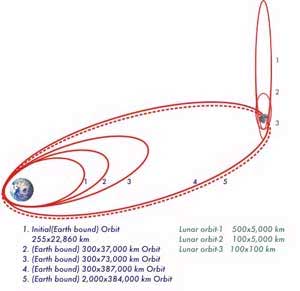Moon Impact Probe launch likely around 14-15 November
11 Nov 2008
Chennai: ISRO scientists have said they will observe the lunar probe Chandrayaan-1's orbit for a day or so before deciding to eject the 29-kg Moon Impact Probe (MIP) on 14 or 15 November. The MIP is a box-shaped instrument that currently sits atop the spacecraft. The probe will crash-land on the lunar surface, and in doing so would also register the country's presence on the moon.
The MIP has the country's flag painted on its sides.
 The Chandrayaan has already settled into a lunar orbit of 200 km periselene (closest to the moon) and 7,502 km aposelene (farthest from the moon). It will settle into its pre-designated circumpolar lunar orbit after another two or three thruster firings aimed at bringing it closer to the lunar surface.
The Chandrayaan has already settled into a lunar orbit of 200 km periselene (closest to the moon) and 7,502 km aposelene (farthest from the moon). It will settle into its pre-designated circumpolar lunar orbit after another two or three thruster firings aimed at bringing it closer to the lunar surface.
In a remarkable display of confidence, ISRO scientists have been experimenting as they have gone along with Chandrayaan to the moon. They have added additional orbits to the spacecraft, when they have felt the need for it and it is likely that they may study the moon's gravity field closely before deciding when to eject the MIP.
According to S Satish, director, publications and public relations, ISRO, ''There have been dynamic changes in our manoeuvres to reach the moon.''
Another mission scientist, S Ramakrishnan, director (projects), Vikram Sarabhai Space Centre, Thiruvananthapuram, said the orbit reduction under way now was the reverse of what was done while approaching the moon. While the four firings of the Liquid Apogee Motor (LAM) soon after entering into elliptical orbit around the earth on 22 October were designed to increase the ellipticity of the spacecraft bringing it closer to the moon in ever wider loops, the LAM firings now will be aimed at reducing the size of its lunar orbit.
On 9 November, the LAM was fired to reduce the spacecraft's orbit around the moon to 7,502 km by 200 km. ''We are now reducing the Chandrayaan's orbit to come closer to the moon,'' Ramakrishnan said. ''The moon's gravity is not well characterised. It is not symmetrical like that of the earth. The moon's gravity is not well understood. So there will be uncertainties. When we fire the engine to reduce the spacecraft's orbit, depending on the response, we have to do further corrections,'' he said.
Ramakrishnan has expressed the confidence that the remaining two manoeuvres would succeed because Chandrayaan-1 was already ''in a stable orbit and it cannot vanish anywhere.''






























